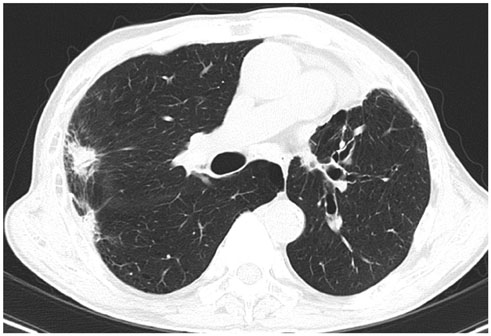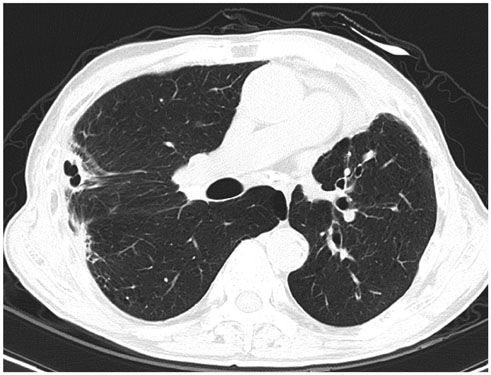J Korean Soc Radiol.
2016 Dec;75(6):466-470. 10.3348/jksr.2016.75.6.466.
Inducing of Complete Necrosis of Recurred Lung Cancer by Cryoablation: A Case Report
- Affiliations
-
- 1Department of Radiology, Korea University Anam Hospital, College of Medicine, Korea University, Seoul, Korea. syohammd@hanmail.net
- KMID: 2360434
- DOI: http://doi.org/10.3348/jksr.2016.75.6.466
Abstract
- Lung cancer is one of the most commonly diagnosed cancers, and the lungs are a common site of metastasis from extrathoracic malignancies. Surgical resection is the gold standard treatment for lung malignancies. However, some of the patients are poor surgical candidates due to various reasons. Currently, image-guided ablation is used as one of the lung cancer treatment modalities. Cryoablation has been adapted as one of the treatments of lung tumors and a growing body of literature has shown that it is a safe and effective option. We report a case of successful cryoablation for a metastatic lesion from surgically resected primary lung cancer.
Figure
Reference
-
1. Ahmed M, Brace CL, Lee FT Jr, Goldberg SN. Principles of and advances in percutaneous ablation. Radiology. 2011; 258:351–369.2. Wang H, Littrup PJ, Duan Y, Zhang Y, Feng H, Nie Z. Thoracic masses treated with percutaneous cryotherapy: initial experience with more than 200 procedures. Radiology. 2005; 235:289–298.3. Zemlyak A, Moore WH, Bilfinger TV. Comparison of survival after sublobar resections and ablative therapies for stage I non-small cell lung cancer. J Am Coll Surg. 2010; 211:68–72.4. Zhang X, Tian J, Zhao L, Wu B, Kacher DS, Ma X, et al. CT-guided conformal cryoablation for peripheral NSCLC: initial experience. Eur J Radiol. 2012; 81:3354–3362.5. Pusceddu C, Sotgia B, Fele RM, Melis L. CT-guided thin needles percutaneous cryoablation (PCA) in patients with primary and secondary lung tumors: a preliminary experience. Eur J Radiol. 2013; 82:e246–e253.6. Inoue M, Nakatsuka S, Yashiro H, Ito N, Izumi Y, Yamauchi Y, et al. Percutaneous cryoablation of lung tumors: feasibility and safety. J Vasc Interv Radiol. 2012; 23:295–302. quiz 305.7. Yamauchi Y, Izumi Y, Hashimoto K, Yashiro H, Inoue M, Nakatsuka S, et al. Percutaneous cryoablation for the treatment of medically inoperable stage I non-small cell lung cancer. PLoS One. 2012; 7:e33223.8. Lee SH, Kim KT, Chung JH, Jo SB, Youn HS, Son HS. Percutaneous cryoablation of lung cancer in high risk patients. Korean J Thorac Cardiovasc Surg. 2006; 39:953–956.9. Park EH, Jin GY, Han YM, Lee YC, Kwon KS. Percutaneous cryotherapy for inoperable lung malignancy. J Korean Soc Radiol. 2012; 66:427–435.10. Kim KY, Jin GY, Han YM, Lee YC, Jung MJ. Cryoablation of a small pulmonary nodule with pure ground-glass opacity: a case report. Korean J Radiol. 2015; 16:657–661.
- Full Text Links
- Actions
-
Cited
- CITED
-
- Close
- Share
- Similar articles
-
- Percutaneous Cryoablation of Multiple Pulmonary Endometriosis
- Percutaneous Cryoablation for the Normal Lung evaluated in Rabbits: A Radiologic-Pathologic Correlation
- Nerve-Sparing Cryoablation for the Treatment of Primary Prostate Cancer: the Preliminary Report
- Total necrosis of small cell lung carcinoma after combination chemotherapy and radiotherapy: one case report-
- Percutaneous cryoablation for hepatocellular carcinoma




